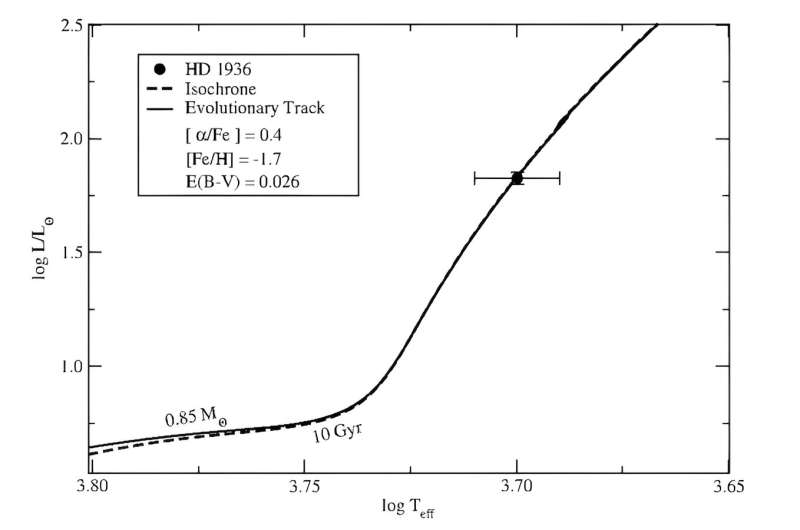February 22, 2024 report
This article has been reviewed according to Science X's editorial process and policies. Editors have highlighted the following attributes while ensuring the content's credibility:
fact-checked
preprint
trusted source
proofread
Study investigates chemical composition of metal-poor star HD 1936

Using the Ankara University Kreiken Observatory (AUKR) in Turkey, astronomers have performed high-resolution spectroscopic observations of a metal-poor star known as HD 1936. Results of the observations campaign, published February 15 on the preprint server arXiv, shed more light on the chemical composition of this star.
Metal-poor stars are rare objects as only a few thousand stars with iron abundances [Fe/H] below -2.0 have been discovered to date. Expanding the still short list of metal-poor stars and studying these objects in detail is of high importance for astronomers, as such stars have the potential to improve our knowledge of chemical evolution of the universe.
HD 1936 (also known as HIP 1873) is a very bright metal-poor star of spectral type G5, located some 1,000 light years away, in the galactic halo. The star, assumed to be about 10 billion years old, is estimated to be at least 10 times larger than the sun, while its mass is most likely between 0.9 and 3.0 solar masses. Some studies have suggested that the star has a substellar companion with a mass of around 18.35 Jupiter masses.
Although previous observations determined the atmospheric parameters of HD 1936, a detailed chemical study of this star has not been conducted yet. That is why a team of Turkish astronomers led by Şeyma Çalışkan of the Ankara University, decided to investigate HD 1936 with the Whoppshel Spectrograph mounted at the AUKR's 0.8-m Berahitdin Albayrak telescope.
"We present chemical abundances of the very bright metal-poor star HD 1936 based on high-resolution and high SNR [signal-to-noise ratio] spectra from AUKR," the researchers wrote.
The team managed to obtain the abundances of 29 atomic species for HD 1936. The metallicity of the star was determined to be at a level of -1.74, which is generally in agreement with previous estimates.
The observations found that HD 1936 is not carbon-enhanced and showcases light as well as odd-Z element abundance ratios mostly compatible with those of metal-poor field stars. The sodium to iron abundance ratio appears to be sub-solar, while the aluminum to iron abundance ratio turned out to be super-solar.
According to the paper, the initial lithium abundance for HD 1936 was measured to be approximately 1.01 dex. This is consistent with what is usually observed in lower red giant branch stars.
The determined abundance ratios of europium and barium suggested very little s-process contamination for the investigated star. This allowed the astronomers to classify HD 1936 as a moderately r-process-enhanced metal-poor star.
The obtained results also suggest that HD 1936 may be a second-generation star formed in a multi-enriched environment. The measured abundance ratio of magnesium to carbon points to the enrichment due to more than one supernova.
More information: Şeyma Çalışkan et al, On the Chemical Composition of the Evolved Very Bright Metal-Poor Star HD 1936, arXiv (2024). DOI: 10.48550/arxiv.2402.09840
Journal information: arXiv
© 2024 Science X Network


















